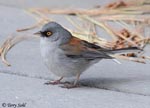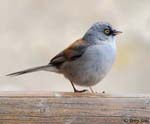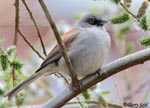| Length: 6 inches | Wingspan: 9 to 10 inches | Seasonality: Non-resident in South Dakota |
| ID Keys: Bright yellow-orange eye, dark lores, bill dark above, light yellow below, gray overall with rusty plumage on back | ||
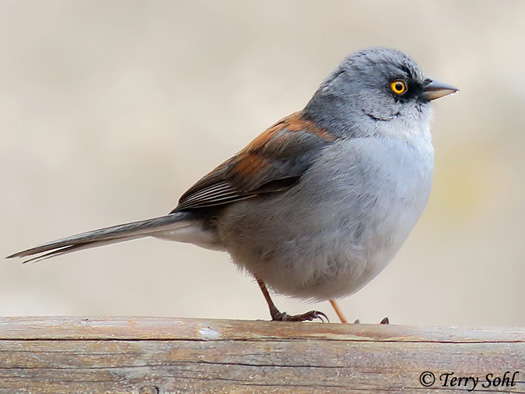 The
Yellow-eyed Junco is a relative of the much more widespread Dark-Eyed Junco.
The namesake yellow eye is the easiest way to differentiate the two species.
In the United States they are found in higher-elevation areas of southern
Arizona and New Mexico. They have a much more expansive range further
south into Mexico.
The
Yellow-eyed Junco is a relative of the much more widespread Dark-Eyed Junco.
The namesake yellow eye is the easiest way to differentiate the two species.
In the United States they are found in higher-elevation areas of southern
Arizona and New Mexico. They have a much more expansive range further
south into Mexico.
Habitat: In the U.S. portion of their range, they are found in the "sky islands" of far southern Arizona and New Mexico, generally at higher-elevation conifer or mixed forest lands. They can also be found around human settlements near these habitats.
Diet: Feeds on both plant material and insects. Seeds make up part of the diet at all times of the year, particularly during the winter months. Insects and other small invertebrates may make up a substantial part of the diet when available in the summer months.
Behavior: Most foraging is done on the ground. They are usually described as being more deliberate and slower when foraging, when compared to the Dark-eyed Junco.
Nesting: The nest is a small cup built of grasses, small roots, and other fine material, placed on the ground, or sometimes low in a bush or tree. It is often placed in a protected location, such as in the shelter of a rock or fallen log. The female lays 3 or 4 eggs.
Song: The song of a Yellow-eyed Junco is a series of thin whistles and trills.
Migration: Considered a permanent resident throughout their range, but they may make local movements to lower elevations in the winter.
Interactive eBird map: Click here to access an interactive eBird map of Yellow-eyed Junco sightings
Similar Species: Similar to Dark-eyed Junco
Feeders: Will come to feeders for seeds, nuts, and breadcrumbs.
Conservation Status: Populations of Yellow-eyed Junco show some indications of a general decline, but they are still found in a large geographic area and are common in parts of that range. The IUCN lists the Yellow-eyed Junco as a species of "Least Concern".
Further Information: 1) WhatBird - Yellow-eyed Junco
2) Audubon - Yellow-eyed Junco
3) USGS Patuxent Bird Identification InfoCenter - Yellow-eyed Junco
Photo Information: April 21st, 2014 - Mount Lemmon, near Tucson, Arizona - Terry Sohl
| Click below for a higher-resolution map |
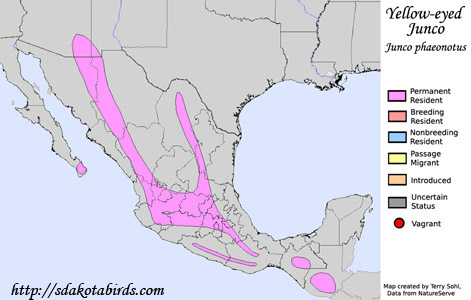 |
| South Dakota Status: Non-resident in South Dakota |
Additional Yellow-eyed Junco Photos
